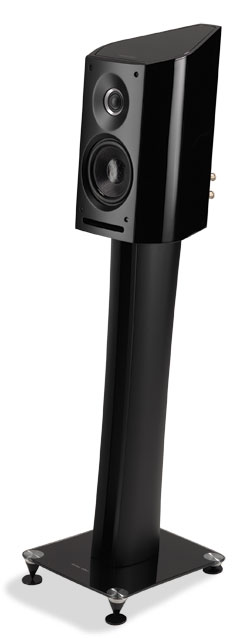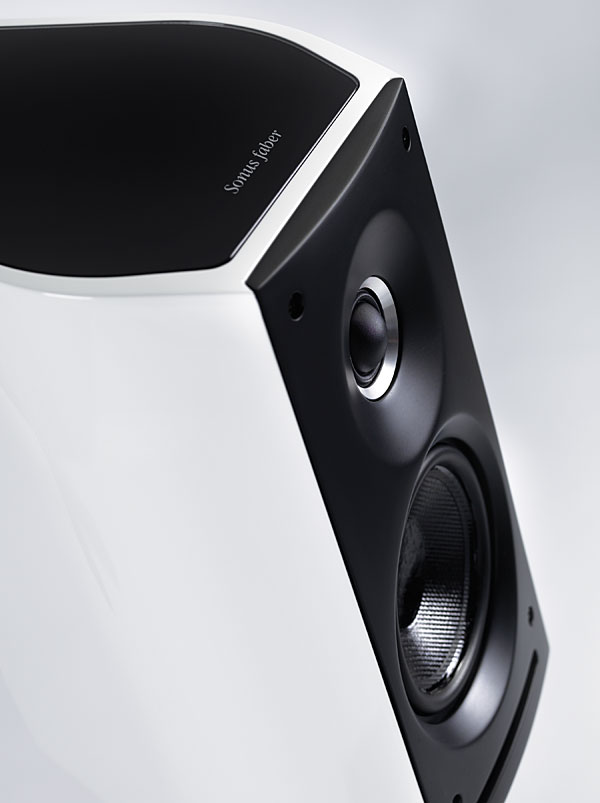| Columns Retired Columns & Blogs |
Sonus Faber Venere 1.5 loudspeaker Page 2
All of the tracks on Miles Davis's In Concert (LP, Columbia/Legacy KG 32092) reproduced the brassy bite and the golden glow of Davis's horn with startlingly three-dimensional realism. In the title track of the Byrds' Turn! Turn! Turn! (LP, Columbia/Sundazed LP 5058), Roger McGuinn's Rickenbacker 12-string electric guitar was appropriately jangly and metallic. In fact, it even seemed a bit forward through the Sonus Faber. Orphée, from John Zorn's Mysterium (CD, Tzadik TZ8018) spotlights Tara Helen O'Connor's flute; its upper register was pure and clean through the 1.5, with all upper harmonics intact. And, on that recording, David Shively's panoply of percussion instruments sounded sparkling and shimmering. Listening to a more intimate recording, I was captivated by the delicacy, detail, and subtle phrasing of Paul Motian's brushed-cymbal textures on Anat Fort's A Long Story (CD, ECM 1994).
 I wondered if the Venere 1.5's ability to delineate all transients with crystalline clarity and detail with no trace of smearing was related to the solidity of the speaker's cabinet and its seamless integration with its stands. As I listened more and more, I mined my collection of percussion recordings. Normally, when I listen to George Crumb's Madrigals (LP, Turnabout TV-S34523), I tend to focus on Elizabeth Suderberg's heavenly soprano—but with the Venere 1.5s, I found myself marveling at how the transient of David Schrader's percussion instruments popped out of thin air on a wide, deep soundstage.
I wondered if the Venere 1.5's ability to delineate all transients with crystalline clarity and detail with no trace of smearing was related to the solidity of the speaker's cabinet and its seamless integration with its stands. As I listened more and more, I mined my collection of percussion recordings. Normally, when I listen to George Crumb's Madrigals (LP, Turnabout TV-S34523), I tend to focus on Elizabeth Suderberg's heavenly soprano—but with the Venere 1.5s, I found myself marveling at how the transient of David Schrader's percussion instruments popped out of thin air on a wide, deep soundstage.
As I selected tracks from Frank Zappa's You Can't Do That On Stage Anymore Vol.2: The Helsinki Concert (3 LPs, Barking Pumpkin 2 BP D1 74217), I homed in on those tracks with significant content by mallet percussionist Ruth Underwood. Listening to a snappy medley of "The Dog Breath Variations" and "Uncle Meat" that, two decades later, influenced the versions on The Yellow Shark, the last recording Zappa made before he died, I followed every gorgeous thwack of Underwood's marimba as the Sonus Faber reproduced the most difficult passages without smear, and with air between each note and the next. It made me think how much I liked the arrangements of these tunes on Zappa's Uncle Meat, his fifth album with the original Mothers of Invention. I think this may be my favorite Zappa album; sonically it was certainly his best, at least on the original Bizarre/Reprise vinyl pressing. And the transient articulation of the fast passages on Egberto Gismonti's Dança das Cabeças (LP, ECM 1089) rendered the master's eight-string guitar with clear delineations of pitch, dynamics, and phrasing.
The Sonus Faber's ability to render layers of inner detail, especially in the midrange, enabled me to hear into familiar recordings in ways I never had before. In his Volumina (LP, Deutsche Grammophon 2543818), György Ligeti coaxes from a pipe organ more subtle timbres and harmonic textures than one usually hears, by exploring dissonances, the instrument's extremes of dynamics and pitch, and even partially opened stops. Every subtlety of organist Gerd Zacher's performance was revealed—throughout the piece, I could pinpoint the precise position of each stop's pipes, despite the dense dissonances in the fortissimo passages, and the near-inaudibility of notes at the opposite end of the dynamic spectrum. On the electric side, I was able to analyze each note, buzz, and hum of Jack White's heavily distorted guitar in "Dead Leaves," from The White Stripes' White Blood Cells (CD, V2 63881-27124-2). I could almost visualize the knob settings on his guitar's distortion device.
The Venere's resolution of midrange detail, combined with its dead-neutral reproduction of timbres in this region, made it an excellent match for well-recorded jazz. On A Long Story, Anat Fort's phrasing in her acoustic piano's middle range was rich, delicate, and involving. With every jazz recording I listened to, woodwind and brass instruments sounded as if they were present in my listening room. Charles Lloyd's tenor sax on his Jumping the Creek (CD, ECM 1911) was silky, sweet, and lyrical. In the arrangement of Duke Ellington's "The Mooche" on Jerome Harris's Rendezvous, recorded by John Atkinson (CD, Stereophile STPH013-2), Marty Ehrlich's alto sax solo was bloomy, and Arthur Baron's trombone solo emerged from the blackness of the recording venue with a startlingly realistic dynamic envelope. Voices, too, shone through this speaker. When I played the minimalist recording of the title track of Bob Dylan's The Times They Are A-Changin', from my original pressing (LP, Columbia 8905) his voice sounded dead natural.
The second coloration I noticed with the Venere 1.5 was a subtle elevation in the mid- to upper bass. This did not, however, add to the bass any resonance or boom. In fact, with most recordings it added a subtly attractive liveliness to recordings with significant energy in this region. The effect was akin to a jazz double-bassist leaning the instrument slightly closer to the mike when playing in the middle of the instrument's range. In fact, the only recording with which this coloration bothered me was "Third World Anthem," from Jack DeJohnette's Selected Recordings (CD, :rarumECM 8012)—I felt his bass drum sounded too thumpy. However, Steve Swallow's electric bass, which can sound overripe through many speakers—Swallow equalizes his instrument to favor the mid- and upper bass—sounded as natural as I've heard him in concert on all tracks of his and Carla Bley's Duets (CD, Watt 20). On the classical side, the lower ranges of Marc Johnson's unaccompanied cello in Chinary Ung's Khse Buon (LP, CRI SD487) were rich and clear, the instrument's woody, rosiny sound shining through without a touch of overemphasis.

The character of the Venere 1.5's mid- and upper bass made it an excellent match for rock recordings, and its ability to resolve high-level dynamic contrasts and play at volumes higher than one might expect to hear from so small a speaker made me want to crank it up. I played all of Herbie Hancock's Future Shock (LP, Columbia FC 38814) at volume levels in excess of 95dB, and both Bill Laswell's electric bass and all the slammin' percussion were tight and extended on the bottom end, with no trace of strain. The Sonus Faber's high-level dynamic capabilities also impressed me with orchestral works, such as Louis Andriessen's De Stijl, as performed by the ASKO and Schönberg Ensembles, conducted by Reinbert De Leeuw (CD, Nonesuch 79342-2), where the high-level dynamic percussion that repeatedly emerge from a silent background were startling in their forcefulness and lack of compression. In fact, the Venere's ability to reproduce the dynamic envelope from ppp to fff was evident with most recordings I sampled. The title track of Charles Mingus's Pithecanthropus Erectus (LP, Atlantic 1237) features ensemble tutti passages; through the Venere 1.5s, the musicians breathed naturally, with an airy presence, in a uniform and linear fashion.
Comparisons
I compared the Sonus Faber Venere 1.5 ($1198) with the Dynaudio Excite X12 ($1200), the Monitor Audio RX6 Silver ($1250), and the Epos M5i ($899, discontinued; all prices per pair).
The Dynaudio Excite X12 has a detailed, airy midrange that was very close to the Sonus Faber's, as well as delicate, detailed highs. However, I felt that while the highs were more extended through the X12s, the Veneres' lower highs were more detailed, articulate, clean, and natural. The Dynaudio's midbass was warmer and not as clean as the Sonus Faber's, and while the X12's transients were very good, they weren't in quite the same league as the Venere's.
Monitor Audio's RX6 Silver had better high-level dynamics and bass extension than the Sonus Faber, but its lower high frequencies weren't as pure, and its sound had less inner detail and delicacy.
The Epos M5i has excellent inner detail and a natural midrange. Its highs were more extended than the Sonus Faber's, and its lower highs were a bit more crisp. The M5i had slightly cleaner midbass, but the Venere 1.5's high-level dynamic contrasts were superior, and I felt its bass extended a bit deeper than the M5i's.
The Finish
In the Venere 1.5, Sonus Faber has produced a natural-, involving-, detailed-, and dynamic-sounding loudspeaker. The Venere shares some of the magic of the more expensive Sonus Faber speakers I've heard in various locations over the years. As such, it's a testament to the ability of creative speaker designers to trickle technology down from the highest of the high end to affordable prices. Without a doubt, it's the most visually attractive bookshelf speaker I've reviewed, and its appearance is likely to blend in with a variety of décors, as well as earn high approval from spouses. Finally, the Venere 1.5's tiny footprint belies the fact that, with any type of music, it was capable of reproducing big music at volume levels that tricked me into thinking I was hearing much larger speakers. I began missing the little Venere 1.5s the moment they left my listening room. A stunning achievement.
- Log in or register to post comments




































